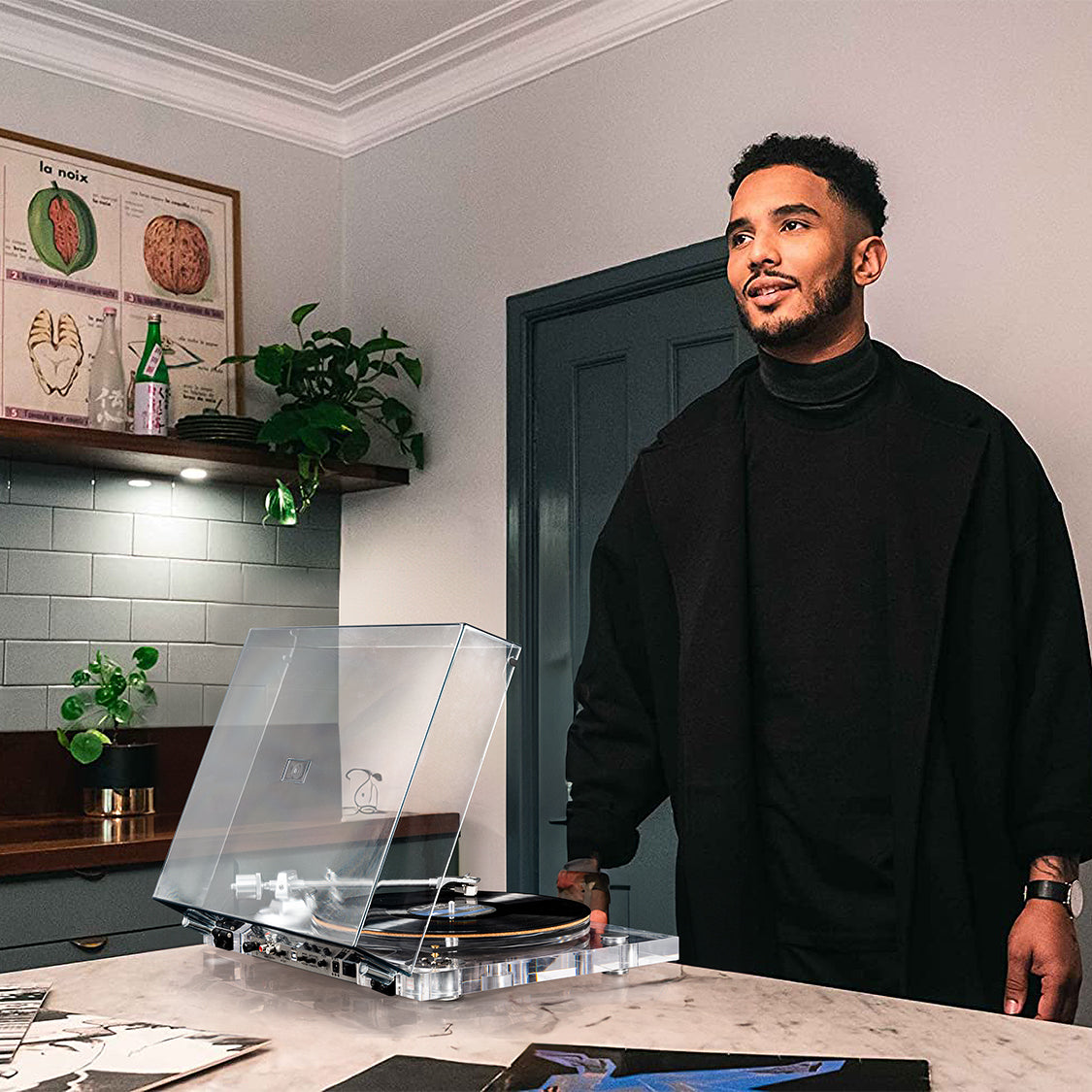Introduction:
For decades, vinyl enthusiasts have embraced the analog warmth and rich sonic characteristics of vinyl records. However, with the rise of wireless technology, the question arises: Does the sound quality have to suffer when listening to vinyl via Bluetooth? In this article, we'll explore how advancements in Bluetooth technology have revolutionized the vinyl listening experience, debunking the myth of poor sound quality and uncovering the keys to achieving high-fidelity audio reproduction with Bluetooth-enabled turntables and speakers. It may not be as good as RCA wired connection, but if Bluetooth has poor sound quality, it’s just that the way it is turned on is wrong:
TIPS: Focus On 3 Elements!!!
-
Bluetooth Version: The latest version is 5.3.
To sum up in one sentence: 4.2 is barely enough, 5.0 is a qualitative change, and it is best to start with 5.0.
| Bluetooth Version | Release Time |
Maximumium Transfer Rate |
Transmission Distance |
| Bluetooth V1.1 | 2002 | 810Kbps | 10m |
| Bluetooth V1.2 | 2003 | 1Mbps | 10m |
| Bluetooth V2.0+EDR | 2004 | 2.1Mbps | 10m |
| Bluetooth V2.1+EDR | 2007 | 3Mbps | 10m |
| Bluetooth V3.0+HS | 2009 | 24Mbps | 10m |
| Bluetooth V4.0 | 2010 | 24Mbps | 100m |
| Bluetooth V4.1 | 2013 | 24Mbps | 100m |
| Bluetooth V4.2 | 2014 | 24Mbps | 100m |
| Bluetooth V5.0 | 2016 | 48Mbps | 300m |
| Bluetooth V5.1 | 2019 | 48Mbps | 300m |
| Bluetooth V5.2 | 2019 | 48Mbps | 300m |
| Bluetooth V5.3 | 2021 | 48Mbps | 300m |
- Bluetooth Audio Encoding Protocol
SBC: Bluetooth official codec protocol, with the worst sound quality.
AAC: Apple loves to promote it and the sound quality has been improved.
LDAC: Exclusive to Sony, Hi-Res sound quality is greatly improved.
LHDC: Similar to Sony Dafa, the launched version 5.0 has surpassed LDAC.
AptX——Look for it when choosing a Bluetooth record player!
Qualcomm patents have five categories, aptX, aptX HD, aptX Low Latency, aptX Adaptive and aptX Lossless. According to the names, they are traditional, high quality, low latency, adaptive and lossless.
A table to understand each encoding protocol and device support:
| Sampling Rate | Bitrate | Compression Ratio | Delay |
Compatible with Turntables |
Compatible Speakers |
|
| SBC | 44.1kHz/16bit | 256kbps | 3-6:1 | 220ms | All Bluetooth Turntables | All Bluetooth Speakers |
| AAC | 44.1kHz/16bit | 310kbps | 18-20:1 | 120-150ms | None | Partially Supported |
| LDAC | 96kHz/24bit; 96kHz/32bit (limit) | 330-990kbps | 4.5:1 |
80-150ms |
None | Partially Supported |
| LHDC | 192kHz/24bit | 129-1000kbps | / | 80ms | None | Partially Supported |
| aptX | 48kHz/16bit | 352kbps | 4:1 | 60-80ms | Partially Supported | Partially Supported |
| aptX LL | 48kHz/16bit | 352kbps | 4:1 | <40ms | None | Partially Supported |
| aptX HD | 48kHz/24bit | 576kbps | 4:1 | >100ms | Partially Supported | Partially Supported |
| aptX Adaptive | 96kHz/24bit | 276-420kbps | 5-10:1 | 50-80ms | Partially Supported | Partially Supported |
- Bluetooth Output and Input Have the Same Specifications at Both Ends
output=phono
Input = speakers/headphones
Many friends only care about whether the Bluetooth of the speaker is a higher version or supports a certain protocol, so they will connect it to a Bluetooth record player by default and the sound effect will not be bad.
For example, a friend thought that buying a Sony record player would have a more stable connection and better sound quality because the Sony speakers at home support LDAC. But in fact, the Bluetooth version of Sony's turntable is 4.2, and it does not support LDAC, so even if it is connected, it can only be transmitted through the SBC traditional Bluetooth protocol, with poor sound quality and high latency.
The current Bluetooth record players only support the AptX protocol, so when choosing speakers, you should also look for speakers that support the AptX protocol to get the best experience.
1. The Evolution of Bluetooth Audio: In recent years, significant advancements in Bluetooth audio codecs, such as aptX HD and LDAC, have bridged the gap between wireless and wired audio transmission. These codecs enable high-resolution audio streaming, delivering near-lossless sound quality comparable to wired connections. Manufacturers have also implemented technologies like Bluetooth 5.0 and enhanced antenna designs to improve signal stability and reduce latency, further enhancing the wireless listening experience.
2. Debunking the Myth: High-Fidelity Bluetooth Vinyl Playback: Contrary to popular belief, listening to vinyl via Bluetooth no longer means sacrificing sound quality. With the right combination of equipment and technology, it's possible to achieve audiophile-grade sound reproduction wirelessly. Modern Bluetooth-enabled turntables, equipped with high-quality phono preamps and aptX HD or LDAC support, ensure faithful reproduction of the vinyl sound signature. Paired with high-fidelity Bluetooth speakers or headphones, the result is a listening experience that rivals traditional wired setups.
3. Choosing the Right Equipment: While Bluetooth technology has made significant strides in improving sound quality, selecting the right turntable and speakers is crucial to maximizing audio performance. When choosing a Bluetooth-enabled turntable, look for models with built-in phono preamps, adjustable gain settings, and support for high-resolution Bluetooth codecs. Similarly, opt for Bluetooth speakers or headphones with aptX HD or LDAC support, as well as premium drivers and amplification for accurate sound reproduction.
4. Tips for Optimizing Bluetooth Vinyl Playback: To ensure optimal sound quality when listening to vinyl via Bluetooth, consider the following tips:
- Positioning: Place your Bluetooth turntable and speakers in an optimal location to minimize signal interference and maximize signal strength.
- Codec Selection: Use the highest-quality Bluetooth codec supported by your equipment to achieve the best possible sound quality.
- Signal Quality: Invest in high-quality Bluetooth cables and adapters to maintain signal integrity and minimize data loss during transmission.
- Room Acoustics: Consider room acoustics and acoustic treatment to enhance the listening environment and reduce reflections and reverberations that may impact sound quality.
5. Conclusion:
In conclusion, the notion that Bluetooth vinyl playback must compromise sound quality is no longer valid. With advancements in Bluetooth audio technology and the availability of high-fidelity Bluetooth-enabled turntables and speakers, it's possible to enjoy the warmth and richness of vinyl records wirelessly. By selecting the right equipment and optimizing your setup, you can achieve audiophile-grade sound reproduction that rivals traditional wired systems, redefining the vinyl listening experience for the modern era.












Leave a comment
All comments are moderated before being published.
This site is protected by hCaptcha and the hCaptcha Privacy Policy and Terms of Service apply.